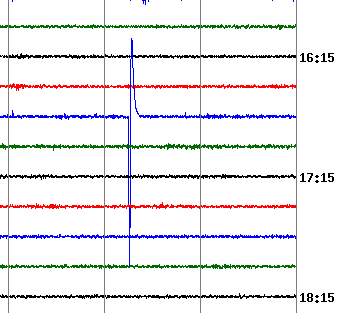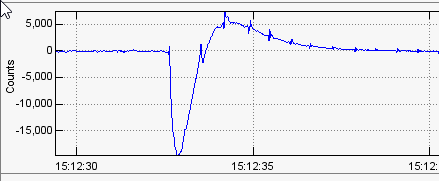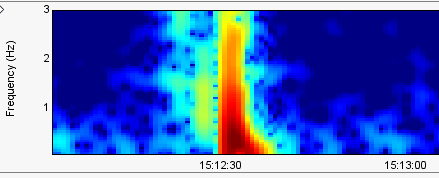I think I read that version 0.18 may have fixed the problem that causes an occasional (perhaps once a month) big “blip” in the helicorder (and data files). However with my new v0.18 download and RPI 4 I did manage to catch one the other day.

FWIW I have attached the diagnostic files
RSH.R363F.2020-10-08T21_12_24.logs.tar (1.3 MB)
Regards
Ken
Hi Ken:
I hope you are well.
version 18 did not address this as this is not a software problem. It is likely from RF interference.
branden
Had this “Blip” happen on my RS4D as well. Here is the fourm post
Hope this helps
lots of RF here - all the time. My RS is well shielded from it.
These blips look like the program is getting one bad reading from the A/D converter - possibly due to some timing issue where it fails only once in a billion cycles or so … now that I have stuck my foot in it, I will have to watch for the next one.
Ken
1 Like
well - there is one more explanation. In reading about seismometer vaults they talk about problems you can have with differential expansion of materials. This causes stress to build up which is eventually relieved by a slip between the materials which makes quite a noise in the seismometer. The frequency of the shock wave could be much higher than the normal range of the seismometer and thus not reproduced clearly. This problem is one reason to use a special concrete mixture - no large aggregate and no rebar. My concrete vault uses this technique: only sand mix with reinforcing fibers rather than rebars. However, the pad that it sits on uses conventional concrete and is attached to a large underground boulder with some rebars cemented into holes drilled in the rock. The rock and the concrete no doubt have different coefficients of expansion. So this could be the problem - a hint might be that it is associated with large prolonged swings in temperature.
As a test today I walked out to the vault and struck the side of the enclosure (near the bottom) with a small wrench. This is the result:

you can see my footsteps 
Here is another view:

This does not look all that different than what we have been seeing once in a great while over time.
So a single-short-sharp-shock with frequency components above 50 Hz certainly could be one cause.
Ken
1 Like
I did make the mistake of not using concrete with low aggregate (in the vault), but so far I have only seen one “blip” so far. Interesting as in SoCal we can have quick and significant temperature changes. Maybe I will see it this summer.
-Southern CA Earthquakes
RS4D RCEA5 Southern CA
1 Like


